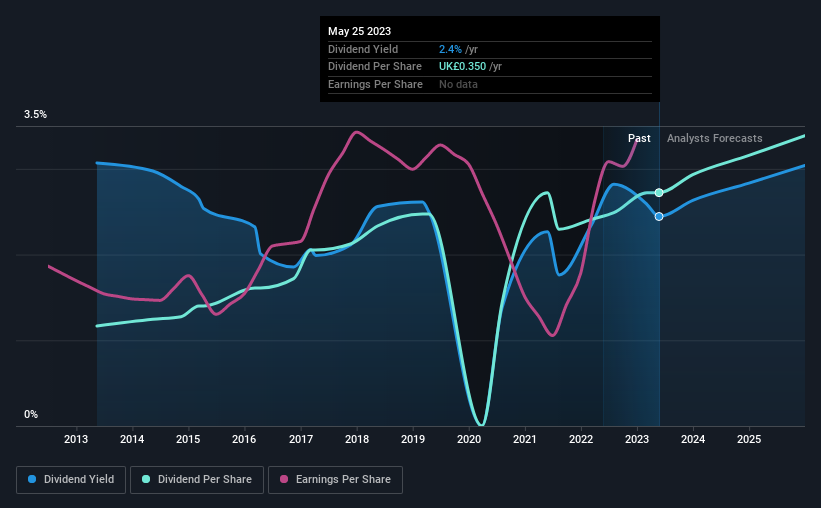- United Kingdom
- /
- Metals and Mining
- /
- LSE:HILS
Hill & Smith (LON:HILS) Is Increasing Its Dividend To £0.22
The board of Hill & Smith PLC (LON:HILS) has announced that it will be paying its dividend of £0.22 on the 7th of July, an increased payment from last year's comparable dividend. This takes the annual payment to 2.4% of the current stock price, which unfortunately is below what the industry is paying.
Check out our latest analysis for Hill & Smith
Hill & Smith's Payment Has Solid Earnings Coverage
Even a low dividend yield can be attractive if it is sustained for years on end. The last payment was quite easily covered by earnings, but it made up 98% of cash flows. The company might be more focused on returning cash to shareholders, but paying out this much of its cash flow could expose the dividend to being cut in the future.
Over the next year, EPS is forecast to expand by 49.8%. If the dividend continues along recent trends, we estimate the payout ratio will be 37%, which is in the range that makes us comfortable with the sustainability of the dividend.

Dividend Volatility
Although the company has a long dividend history, it has been cut at least once in the last 10 years. The annual payment during the last 10 years was £0.15 in 2013, and the most recent fiscal year payment was £0.35. This means that it has been growing its distributions at 8.8% per annum over that time. It's good to see the dividend growing at a decent rate, but the dividend has been cut at least once in the past. Hill & Smith might have put its house in order since then, but we remain cautious.
The Dividend's Growth Prospects Are Limited
Given that the dividend has been cut in the past, we need to check if earnings are growing and if that might lead to stronger dividends in the future. Although it's important to note that Hill & Smith's earnings per share has basically not grown from where it was five years ago, which could erode the purchasing power of the dividend over time.
Hill & Smith's Dividend Doesn't Look Sustainable
Overall, we always like to see the dividend being raised, but we don't think Hill & Smith will make a great income stock. While the low payout ratio is a redeeming feature, this is offset by the minimal cash to cover the payments. We would probably look elsewhere for an income investment.
Companies possessing a stable dividend policy will likely enjoy greater investor interest than those suffering from a more inconsistent approach. Still, investors need to consider a host of other factors, apart from dividend payments, when analysing a company. As an example, we've identified 1 warning sign for Hill & Smith that you should be aware of before investing. Is Hill & Smith not quite the opportunity you were looking for? Why not check out our selection of top dividend stocks.
Valuation is complex, but we're here to simplify it.
Discover if Hill & Smith might be undervalued or overvalued with our detailed analysis, featuring fair value estimates, potential risks, dividends, insider trades, and its financial condition.
Access Free AnalysisHave feedback on this article? Concerned about the content? Get in touch with us directly. Alternatively, email editorial-team (at) simplywallst.com.
This article by Simply Wall St is general in nature. We provide commentary based on historical data and analyst forecasts only using an unbiased methodology and our articles are not intended to be financial advice. It does not constitute a recommendation to buy or sell any stock, and does not take account of your objectives, or your financial situation. We aim to bring you long-term focused analysis driven by fundamental data. Note that our analysis may not factor in the latest price-sensitive company announcements or qualitative material. Simply Wall St has no position in any stocks mentioned.
About LSE:HILS
Hill & Smith
Manufactures and supplies infrastructure products in the United Kingdom, rest of Europe, North America, the Middle East, rest of Asia, and internationally.
Flawless balance sheet average dividend payer.
Market Insights
Community Narratives



